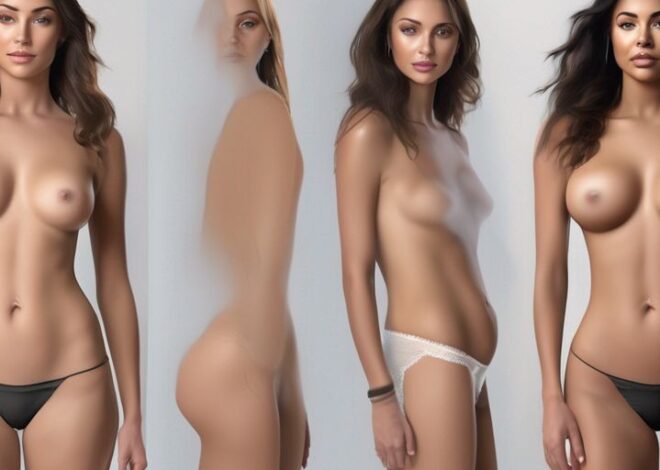
Examining ‘Porn AI Undress’: Ethical Concerns and Legal Issues
The emergence of ‘Porn AI Undress’ technologies, particularly through platforms like Nudify.Online, has sparked a significant debate surrounding the ethical, legal, and psychological ramifications of such tools. As these technologies employ advanced AI to digitally remove clothing from images, they raise profound questions about privacy, consent, and the broader implications for society. This article delves into the multifaceted impact of AI-driven undressing technologies, exploring the ethical concerns, legal landscape, psychological effects on victims, public reaction, and the potential for technological countermeasures.
Key Takeaways
- Nudify.Online represents a significant advancement in AI technology with its ability to digitally undress images, posing serious ethical and privacy concerns.
- The lack of explicit consent from individuals whose images are manipulated by such technologies highlights critical issues regarding personal autonomy and privacy.
- Current legal frameworks are often inadequate to address the rapid development and deployment of AI undressing technologies, resulting in significant legal gaps.
- Victims of AI-driven image manipulation can suffer severe emotional and psychological distress, necessitating robust support systems and protective measures.
- The development of protective technologies and educational initiatives are crucial for safeguarding personal privacy against the misuse of AI capabilities in the future.
Overview of ‘Porn AI Undress’ Technology

How Nudify.Online Works
Nudify.Online is an advanced web-application designed to strip off clothes from people in images online, using the most advanced clothes-removing AI technology of 2024. This platform allows users to upload photos and receive a version with the subjects undressed, raising significant ethical and privacy concerns.
Technological Mechanisms Behind AI Undressing
The core technology involves sophisticated algorithms that analyze the clothing in images and reconstruct the human body as it might appear without clothes. This process relies heavily on machine learning models trained on vast datasets of nude images, which pose potential risks of misuse.
Comparison with Previous Technologies
Previous technologies in digital image manipulation were limited to simple filters and editing tools that required manual input. The advent of AI-driven tools like Nudify.Online represents a significant leap in capability, allowing for automated, realistic transformations of clothed to unclothed images.
Ethical Implications of AI-Driven Undressing

Privacy Concerns
The use of AI to digitally remove clothing from images without consent directly infringes on an individual’s right to privacy. This technology can be used to create images that the subject never intended to be public, leading to potential misuse and privacy violations.
Consent Issues
AI-driven undressing technologies operate without the explicit consent of the individuals depicted, which raises significant ethical questions. The lack of consent is a critical issue, as it bypasses personal autonomy and the right to control one’s own image.
Impact on Social Norms
The widespread availability of such technologies could alter societal perceptions of privacy and decency. It might normalize the non-consensual use of someone’s image, thereby eroding respect for personal boundaries and increasing the acceptance of digital exploitation.
Legal Landscape Surrounding AI Undressing Technologies

Current Laws and Regulations
The legal framework governing AI undressing technologies is still in its nascent stages. Most countries lack specific laws that address the unique challenges posed by these technologies. However, general privacy and data protection laws may apply. For instance, the GDPR in the EU provides some safeguards by requiring consent for processing personal data, which could include images manipulated by AI.
Legal Gaps and Challenges
The rapid advancement of AI technologies has outpaced the development of corresponding legal frameworks. This has created significant gaps, particularly in areas like consent and unauthorized use of personal images. The lack of clear legal definitions and standards for AI-generated content makes enforcement challenging and leaves victims with few recourses.
International Legal Perspectives
Different countries have varied approaches to regulating technology that affects personal privacy. For example, the U.S. has a more decentralized approach, relying heavily on state laws, while the EU has more comprehensive regulations at the continental level. This disparity can lead to confusion and inconsistency in legal enforcement across borders, complicating the global management of AI undressing technologies.
Psychological Effects on Victims

Emotional Distress
The immediate emotional distress caused by AI undressing technologies can be profound. Victims often experience feelings of violation, embarrassment, and a deep sense of powerlessness. These emotions can escalate to anxiety and depression, particularly when images are shared widely.
Long-term Psychological Impact
Long-term effects of such technologies can alter a person’s self-esteem and trust in digital spaces. The fear of re-victimization can lead to social withdrawal and heightened paranoia about online interactions.
Case Studies of Affected Individuals
Several case studies highlight the severe psychological toll on individuals. For instance, victims report long-lasting effects such as:
- Persistent anxiety
- Loss of trust in digital platforms
- Difficulty in forming new relationships
- Increased vigilance and security measures in personal digital interactions
Public and Media Reaction to ‘Porn AI Undress’

Media Coverage
The media has played a significant role in shaping public perception of technologies like Nudify.Online. Coverage has ranged from critical analyses highlighting the ethical dilemmas to more sensational stories that focus on the technology’s misuse. Bold debates have emerged regarding the balance between technological innovation and personal privacy.
Public Opinion
Public opinion on AI-driven undressing technologies is deeply divided. Surveys indicate a split between those who see potential benefits in AI advancements and those who are concerned about privacy and ethical implications:
- 45% express deep concerns about privacy violations
- 30% are curious about the technology’s potential uses
- 25% are indifferent or unaware of the issues
Activism and Backlash
The release of Nudify.Online has sparked significant activism, with groups advocating for stricter regulations to protect personal privacy. Campaigns and protests have been organized to raise awareness and push for legal changes. This movement has highlighted the need for a societal dialogue about the boundaries of technology and privacy.
Technological Countermeasures and Solutions

Development of Protective Technologies
In response to the rise of AI undressing technologies, there has been a significant push towards developing protective technologies. These include AI systems that can detect and block the unauthorized use of personal images for undressing purposes. Key advancements have been made in digital watermarking and image rights management to safeguard digital content.
Role of Cybersecurity
Cybersecurity plays a crucial role in combating the misuse of AI technologies. Enhanced security protocols and robust encryption methods are essential to protect sensitive data from being exploited. The integration of AI with cybersecurity can provide more dynamic and adaptive solutions to these emerging threats.
Educational Initiatives
To combat the misuse of AI in undressing technologies, educational initiatives are crucial. Public awareness campaigns and educational programs can help inform individuals about the risks associated with these technologies and the importance of protecting personal digital content. These efforts are vital in fostering a more informed and cautious online community.
Future of AI in Personal Privacy

Predictions and Trends
The trajectory of AI in personal privacy is poised to evolve significantly. Predictive analytics and machine learning will likely become more pervasive, enhancing the ability to safeguard personal data yet raising new privacy concerns. The integration of AI with IoT devices will further complicate privacy dynamics, necessitating advanced regulatory measures.
Ethical AI Development
Developing AI technologies ethically is crucial to ensure they respect user privacy and consent. This involves transparent data usage policies and the inclusion of privacy by design in AI systems. Ethical guidelines and frameworks will play a pivotal role in shaping the development of privacy-centric AI solutions.
Balancing Innovation with Privacy
The challenge of balancing technological innovation with privacy rights will intensify. Stakeholders must collaborate to establish a consensus on acceptable practices and privacy standards. This balance is essential for fostering trust and encouraging the responsible use of AI technologies.
Conclusion
The emergence of technologies like ‘Porn AI Undress’ raises significant ethical and legal questions that society must address. While the technology showcases impressive advancements in AI capabilities, its application in stripping individuals of their privacy without consent is deeply troubling. The potential for misuse and harm is substantial, necessitating stringent regulations and ethical guidelines to govern its use. As we continue to navigate the complexities of digital ethics, it is crucial to balance technological innovation with respect for individual rights and dignity.
Frequently Asked Questions
What is ‘Porn AI Undress’ technology?
‘Porn AI Undress’ technology, exemplified by platforms like Nudify.Online, uses advanced AI algorithms to digitally remove clothing from images of individuals, presenting numerous ethical and legal challenges.
How does Nudify.Online work?
Nudify.Online operates by employing sophisticated AI technologies that analyze images uploaded by users and manipulate them to appear as though the individuals in the images are undressed.
What are the primary ethical concerns associated with AI-driven undressing technologies?
The primary ethical concerns include violations of privacy, lack of consent from the individuals depicted, and the potential normalization of non-consensual digital manipulation.
What legal protections exist against the misuse of AI undressing technologies?
Currently, legal frameworks vary widely, with some jurisdictions lacking specific laws against AI-driven undressing, leading to significant legal gaps and challenges.
How do victims of AI undressing typically react?
Victims often experience significant emotional distress, with long-term psychological impacts due to the unauthorized and invasive use of their images.
Are there any technological countermeasures to protect against AI undressing?
Yes, there are ongoing developments in protective technologies, including more robust digital rights management and image tracking systems, aimed at preventing unauthorized use of images.



